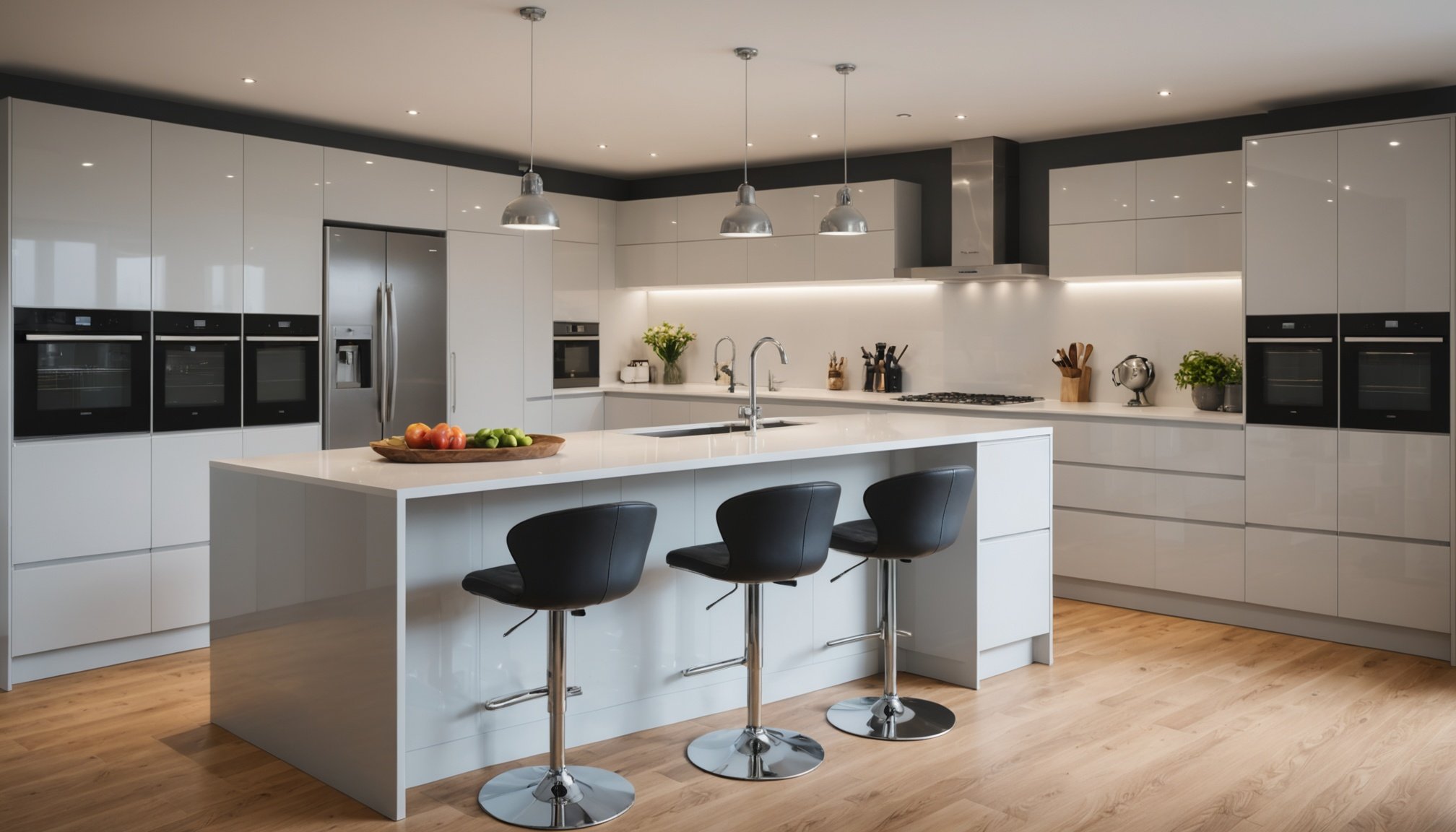Master UK Building Regulations: Your Comprehensive Guide to a Stunning Kitchen Transformation
Understanding the Need for a Kitchen Extension
When it comes to transforming your home, a kitchen extension is one of the most rewarding and valuable projects you can undertake. Not only does it add significant space and functionality to your home, but it also has the potential to boost your property’s value. However, before you embark on this exciting journey, it’s crucial to understand the UK building regulations that govern such projects.
Planning Permission: Do You Need It?
One of the first and most critical questions you’ll need to answer is whether your kitchen extension requires planning permission. In the UK, many kitchen extensions fall under what is known as Permitted Development (PD) rights, which mean you do not need to submit a formal planning application.
Topic to read : Explore the Game-Changing, Eco-Friendly Kitchen Cabinet Innovations Redefining Sustainability in 2023
To qualify for Permitted Development, your kitchen extension must adhere to specific criteria:
- It must be a single-storey extension and not more than 4 meters high (or 3 meters if within 2 meters of a boundary)[3][4].
- For detached houses, the extension can extend up to 8 meters beyond the rear wall, and for semi-detached or terraced houses, it can extend up to 6 meters[3].
- The extension must not cover more than 50% of the land surrounding the house and must not exceed half the width of the original house[3].
Here is a detailed breakdown of what you can build under Permitted Development:
Additional reading : Top Secrets to Extend the Life of Your Wooden Kitchen Utensils: Proven Care Practices;195Mastering Kitchen Drawer Organization: Expert Tips and Proven Strategies for Peak Efficiency
Single-Storey Rear Extensions
- Can extend up to 8 meters beyond the rear wall for detached houses and up to 6 meters for other types of houses.
- Must be less than 4 meters in height.
- Must be no more than half the width of the original house[3].
Side Extensions
- Must be single-storey and less than 4 meters in height (less than 3 meters if within 2 meters of a boundary).
- Cannot be built between the property and a highway.
- Must not exceed half the width of the original house[3].
Building Regulations: Ensuring Compliance
Even if your kitchen extension falls under Permitted Development, it still needs to comply with UK Building Regulations. These regulations ensure that the construction work is safe and meets specific standards.
Here are some key aspects to consider:
Foundations and Groundwork
- The first steps in building your kitchen extension involve laying the foundations. This includes digging, installing pipework and drainage systems, and laying concrete flooring[1].
Electrical and Plumbing Work
- All electrical and plumbing work must be carried out by qualified professionals and must meet the Building Regulations. This includes installing new wiring, sockets, and plumbing appliances[1].
Insulation and Energy Efficiency
- Your new kitchen extension must meet current energy efficiency standards. This includes proper insulation, energy-efficient windows, and compliant roofing materials[3].
Building Control
- You will need to hire a building control officer to inspect your project at various stages to ensure it meets the Building Regulations. This can be done through your local council or an independent inspector[3].
Here is a step-by-step guide on what to expect during the construction process:
Step-by-Step Guide to Building a Kitchen Extension
Week 1: Preparation
- Ensure access to the site is clear.
- Get all building materials delivered.
- Ensure the area is safe and ready for building[1].
Week 2-3: Foundations
- Builders will dig up the foundations.
- Building control will attend to approve the new foundations.
- Reinforcements and pipework will be installed[1].
Week 4-12: Construction
- Walls, windows, and doors will be installed.
- Roofing will be completed.
- Electrical and plumbing work will be carried out.
- Flooring and kitchen units will be installed[1].
Week 13: Final Checks
- Any issues will be reported and rectified.
- This includes heating, electrical, and plumbing checks[1].
Week 14: Final Inspection
- Building control will return to sign off on the finished project[1].
Hiring the Right Builder
Choosing the right builder is crucial for the success of your kitchen extension project. Here are some tips to help you find and hire a reputable contractor:
Research and Recommendations
- Ask for recommendations from friends, family, or neighbors who have recently completed similar projects.
- Check online reviews and ratings on platforms like MyJobQuote[1].
Qualifications and Experience
- Ensure the builder has the necessary qualifications and experience in building kitchen extensions.
- Check if they are members of professional bodies like the Federation of Master Builders[1].
Quotes and Contracts
- Get detailed quotes from multiple builders.
- Ensure the contract includes all aspects of the project, including timelines, materials, and costs[1].
Here is a list of what to look for when hiring a builder:
What to Look for When Hiring a Builder
- Qualifications and Certifications: Ensure the builder is qualified and certified.
- Experience: Check their experience in building kitchen extensions.
- Insurance: Ensure they have the necessary insurance coverage.
- References: Ask for references and check online reviews.
- Detailed Quotes: Get a detailed quote that includes all costs and timelines.
- Contract: Ensure the contract is comprehensive and includes all aspects of the project.
Budgeting for Your Kitchen Extension
Budgeting is a critical part of any home renovation project. Here are some key costs to consider:
Average Costs
- The average cost of a kitchen extension in the UK is around £30,000, but this can vary widely depending on the size and complexity of the project[1].
Cost Breakdown
Here is a detailed cost breakdown for different types of kitchen extensions:
| Type and Size of Extension | Average Cost |
|---|---|
| Basic Kitchen Extension – Small (15m²) | £12,000 – £16,000 |
| Basic Kitchen Extension – Medium (24m²) | £19,000 – £26,000 |
| Basic Kitchen Extension – Large (48m²) | £38,000 – £52,000 |
| Average Kitchen Extension – Small (15m²) | £19,000 – £26,000 |
| Average Kitchen Extension – Medium (24m²) | £26,000 – £34,000 |
| Average Kitchen Extension – Large (48m²) | £52,000 – £67,000 |
| Deluxe Kitchen Extension – Small (15m²) | £21,000 – £30,000 |
| Deluxe Kitchen Extension – Medium (24m²) | £34,000 – £48,000 |
| Deluxe Kitchen Extension – Large (48m²) | £67,000 – £100,000 |
Additional Costs
- Building Regulations approval fees
- Party Wall Agreement fees
- Structural calculations by a structural engineer
- Architectural drawings (around £700 for a single-storey extension)[3].
Designing Your New Kitchen
The design of your new kitchen is where your vision comes to life. Here are some tips to help you create a stunning and functional space:
Open Plan Design
- Consider an open plan design to create a seamless transition between your kitchen and living areas.
- This can make your home feel more spacious and modern[3].
Kitchen Layout
- Plan your kitchen layout carefully to ensure it is functional and efficient.
- Consider the “golden triangle” concept where your sink, stove, and refrigerator form the points of a triangle to optimize workflow[3].
Materials and Finishes
- Choose materials and finishes that are durable and easy to maintain.
- Consider energy-efficient appliances and sustainable materials to align with current trends and regulations[3].
Here is what Robert Quinton, director of Construction Megastore, has to say about designing your new kitchen:
“Designing your new kitchen is an exciting part of the process. Ensure you choose materials and layouts that are both functional and aesthetically pleasing. Remember to consider the flow of your kitchen and how it will integrate with the rest of your home.”
Practical Insights and Actionable Advice
Here are some practical insights and actionable advice to help you navigate your kitchen extension project smoothly:
Communicate with Your Neighbors
- If you live in an attached property, ensure you communicate with your neighbors about your plans.
- You may need to obtain a Party Wall Agreement, and keeping your neighbors informed can help avoid any potential issues[3].
Plan for Unexpected Costs
- Always plan for unexpected costs and delays.
- Having a contingency fund can help you manage any unforeseen expenses that may arise during the project[1].
Ensure Your Budget Aligns with Your Design
- Make sure your budget aligns with your design aspirations.
- Prioritize what is most important to you and be prepared to make compromises if necessary[1].
Here is a summary of the key points to keep in mind:
Key Points to Remember
- Planning Permission: Check if your project falls under Permitted Development rights.
- Building Regulations: Ensure your project complies with UK Building Regulations.
- Hiring a Builder: Choose a reputable and experienced builder.
- Budgeting: Plan for all costs, including unexpected expenses.
- Design: Create a functional and aesthetically pleasing design.
- Communication: Communicate with your neighbors and ensure all necessary permissions are obtained.
By following this comprehensive guide, you can ensure that your kitchen extension project is a success, adding both value and functionality to your home. Remember to stay informed, plan carefully, and enjoy the process of transforming your kitchen into the heart of your home.











